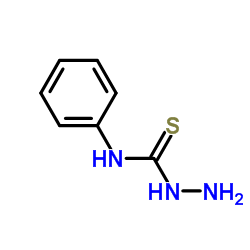4-phenyl-3-thiosemicarbazide

4-phenyl-3-thiosemicarbazide structure
|
Common Name | 4-phenyl-3-thiosemicarbazide | ||
|---|---|---|---|---|
| CAS Number | 5351-69-9 | Molecular Weight | 167.232 | |
| Density | 1.3±0.1 g/cm3 | Boiling Point | 287.4±23.0 °C at 760 mmHg | |
| Molecular Formula | C7H9N3S | Melting Point | 138-140 °C(lit.) | |
| MSDS | Chinese USA | Flash Point | 127.6±22.6 °C | |
| Symbol |

GHS06 |
Signal Word | Danger | |
| Name | 4-Phenylthiosemicarbazide |
|---|---|
| Synonym | More Synonyms |
| Density | 1.3±0.1 g/cm3 |
|---|---|
| Boiling Point | 287.4±23.0 °C at 760 mmHg |
| Melting Point | 138-140 °C(lit.) |
| Molecular Formula | C7H9N3S |
| Molecular Weight | 167.232 |
| Flash Point | 127.6±22.6 °C |
| Exact Mass | 167.051712 |
| PSA | 82.17000 |
| LogP | 0.93 |
| Vapour Pressure | 0.0±0.6 mmHg at 25°C |
| Index of Refraction | 1.727 |
| Water Solubility | methanol: 50 mg/mL, clear |
CHEMICAL IDENTIFICATION
HEALTH HAZARD DATAACUTE TOXICITY DATA
|
| Symbol |

GHS06 |
|---|---|
| Signal Word | Danger |
| Hazard Statements | H300 |
| Precautionary Statements | P264-P301 + P310 |
| Personal Protective Equipment | Eyeshields;Faceshields;Gloves;type P2 (EN 143) respirator cartridges |
| Hazard Codes | T,Xi |
| Risk Phrases | R25 |
| Safety Phrases | S45 |
| RIDADR | UN 2811 6.1/PG 2 |
| WGK Germany | 3 |
| RTECS | VT4025000 |
| Packaging Group | III |
| Hazard Class | 6.1 |
| HS Code | 2930909090 |
| HS Code | 2930909090 |
|---|---|
| Summary | 2930909090. other organo-sulphur compounds. VAT:17.0%. Tax rebate rate:13.0%. . MFN tariff:6.5%. General tariff:30.0% |
|
Determination of trace heavy metals in soil and sediments by atomic spectrometry following preconcentration with Schiff bases on Amberlite XAD-4.
J. Hazard. Mater. 165(1-3) , 1165-9, (2009) A matrix separation and analyte preconcentration system using Amberlite XAD copolymer resins functionalized by Schiff base reactions coupled with atomic spectrometry has been developed. Three differen... |
|
|
Synthesis, characterization, and antifungal activity of boron-containing thiosemicarbazones.
Chem. Biodivers. 5(11) , 2415-22, (2008) Addition of thiosemicarbazide, 4-allylthiosemicarbazide, and 4-phenylthiosemicarbazide to (formylphenyl)boronic acids affords a series of thiosemicarbazones containing boronic acids. Addition of 2-for... |
| N-Phenylhydrazinecarbothioamide |
| EINECS 226-329-1 |
| Hydrazinecarbothioamide, N-phenyl- |
| 1-amino-3-phenylthiourea |
| hydrazinecarboximidothioic acid, N-phenyl- |
| MFCD00007615 |
| N1-phenylhydrazine-1-carbothioamide |
| 4-phenyl-3-thiosemicarbazide |
| N-phenylhydrazinecarbimidothioic acid |

